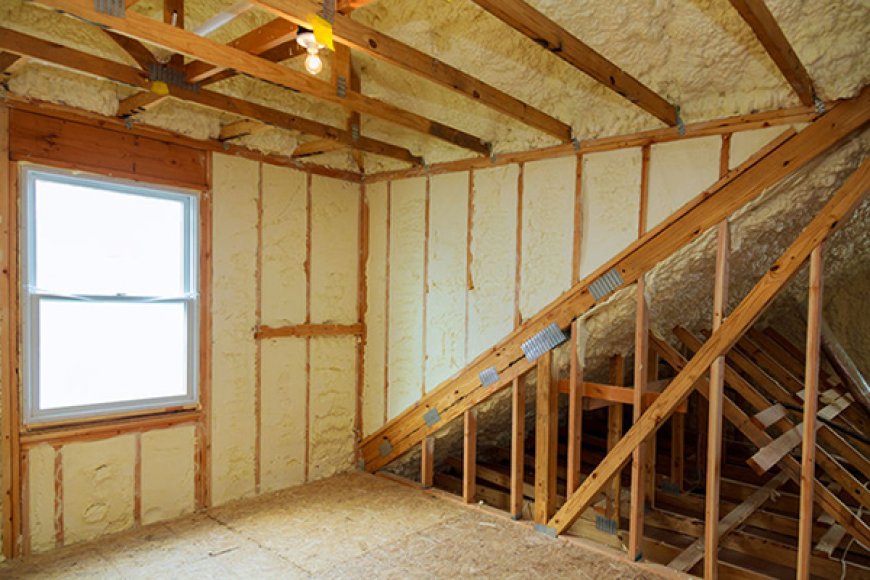Benefits of Residential Spray Foam Insulation for Homeowners

Insulation plays a direct role in how comfortable and energy-efficient a home feels year-round. Among the available options, residential insulation stands out for reducing air leakage, improving indoor comfort, and cutting utility costs. It delivers both thermal resistance and air sealing in one application, giving it a dual advantage over traditional insulation types like fiberglass or cellulose.
This article explains the long-term benefits homeowners can expect from installing spray foam insulation in their houses. Youll learn how it affects energy savings, air quality, moisture control, and moremaking it easier to determine if this insulation solution suits your property.
Improved Energy Efficiency and Lower Utility Costs
Insulation directly impacts how hard your heating and cooling systems work throughout the year. Spray foam provides a seamless barrier that helps regulate indoor temperature more effectively.
High R-Value and Thermal Resistance
The R-value measures insulation's thermal resistance. Spray foam, especially closed-cell types, offers some of the highest R-values per inch.
-
Closed-cell foam: R-6 to R-7 per inch
-
Open-cell foam: R-3.5 to R-4 per inch
Because spray foam adheres to every surface, it eliminates gaps that traditional batts often miss, leading to a more thermally secure building envelope.
Sealing Air Leaks Reduces HVAC Load
Air leaks are one of the biggest contributors to wasted energy in homes. Spray foam acts as both insulation and an air barrier, closing off cracks around plumbing penetrations, wall joints, and attic areas.
This leads to less strain on HVAC equipment, more stable indoor temperatures, and fewer hot and cold spots throughout the home.
Moisture Control and Mold Prevention
Controlling moisture is just as important as controlling temperature. Moisture entering wall cavities or attic spaces can lead to mold growth and structural damage.
Water-Resistant Properties
Closed-cell spray foam insulation resists water penetration, making it useful in areas prone to humidity or flooding. It acts as a moisture barrier in crawl spaces and basements, prevents condensation in attics and wall cavities, and reduces the risk of wood rot and mold development.
Unlike traditional fiberglass insulation, which absorbs moisture, spray foam remains dry and intact even in damp conditions.
Long-Term Structural Reinforcement
Spray foam does more than just insulateit strengthens the surfaces it adheres to, which can help preserve a homes structural integrity.
Wall and Roof Reinforcement
Closed-cell spray foam hardens after application, providing additional rigidity to walls, ceilings, and roof decks. This helps support overall durability in high-wind zones, stabilizes framing under pressure, and reduces vibration and wall movement. Its especially valuable in hurricane-prone or earthquake-sensitive regions.
Sound Dampening Qualities
Noise control is often an overlooked benefit of insulation. Open-cell spray foam helps minimize sound transfer between rooms and from the outside.
Acoustic Insulation Features
Spray foam absorbs sound vibrations and reduces airborne noise through interior walls, floors between levels, and areas like home offices or media rooms. Although its not a complete soundproofing material, it creates noticeably quieter indoor spaces compared to homes with little or no insulation.
Comparative Overview of Spray Foam vs. Other Insulation
|
Feature |
Spray Foam |
Fiberglass |
Cellulose |
|---|---|---|---|
|
R-Value per inch |
R-3.5 to R-7 |
R-2.2 to R-3.8 |
R-3.2 to R-3.8 |
|
Air sealing |
Excellent |
Poor |
Moderate |
|
Moisture resistance |
High (closed-cell) |
Low |
Moderate |
|
Mold and pest resistance |
High |
Low |
Moderate |
|
Lifespan |
20+ years |
1015 years |
1520 years |
Suitable Areas for Installation
Spray foam is versatile and can be used in nearly every part of a residential structure. Strategic placement is important for maximizing performance.
Where It Works Best
Ideal installation zones include attic floors and roof rafters, wall cavities (especially exterior walls), rim joists in basements, crawl spaces and foundations, and around windows and plumbing entries. Proper application ensures air and thermal control across the building envelope, especially in high-loss areas like attics and crawlspaces.
Installation Considerations and Safety
Although DIY kits are available, residential spray foam installation should usually be handled by trained technicians. Improper installation can lead to off-gassing issues or poor performance.
Why Professional Installation Is Recommended
Hiring a certified contractor ensures accurate mixing and application, even thickness across surfaces, safe handling of chemicals and curing process, and compliance with building codes. An experienced installer ensures the foam expands correctly and cures without emitting harmful fumes indoors.
Common Questions
Is spray foam insulation safe for people with allergies?
Yes, once fully cured, spray foam insulation is inert and does not release particles into the air. It reduces dust and allergen infiltration by sealing out outside air, improving indoor air quality.
How long does spray foam insulation last in a home?
Most spray foam applications last over 20 years without significant degradation. Closed-cell varieties offer longer structural durability, while both types maintain performance with minimal upkeep.
Can it be installed in existing homes?
Yes. Spray foam is suitable for both retrofit and new construction. It can be injected into wall cavities through small holes or applied directly in open attic and crawl spaces.
Does spray foam add resale value to a home?
Improved insulation can increase a home's value by lowering energy bills, making the house more appealing to buyers. Its often seen as a long-term energy efficiency upgrade.
Conclusion
Residential spray foam insulation provides reliable long-term value for homeowners focused on comfort, savings, and indoor quality. It performs multiple rolesinsulator, air barrier, moisture blockermaking it a smart choice for improving a home's energy profile and durability.
From reducing HVAC demand to stopping drafts and preventing mold, spray foam insulation addresses core issues many homeowners face with outdated or underperforming materials. When professionally installed and correctly applied, it offers performance and reliability that typically outweigh the upfront cost.
For professional residential spray foam installation, consult with qualified insulation contractors in your area.
FAQs
Whats the difference between open-cell and closed-cell spray foam? Open-cell spray foam is softer, more flexible, and allows some moisture vapor through. Closed-cell is denser, more rigid, and acts as both a moisture and air barrier, ideal for exterior walls and roofs.
Can spray foam be installed during winter? Yes, but ambient and surface temperatures must meet manufacturer guidelines. Most professional contractors use heated equipment to maintain correct conditions during cold-weather installation.
Is spray foam environmentally friendly? Modern formulations use low-global warming potential (GWP) blowing agents. Closed-cell types often improve energy efficiency enough to offset their environmental footprint within a few years.
Will it shrink or settle over time? Properly installed spray foam does not shrink or settle. It adheres tightly to framing and sheathing, maintaining its shape and effectiveness throughout its service life.
How thick should spray foam insulation be? Typical residential applications range from 23 inches for closed-cell in walls and roofs to 56 inches for open-cell in attics. The required thickness depends on climate and building code requirements.
Reviewer: Michael Carter reviewed this article using insight gained over 12 years in the spray foam business. His feedback focused on helping contractors reach new customers without overcomplicating their message.









































